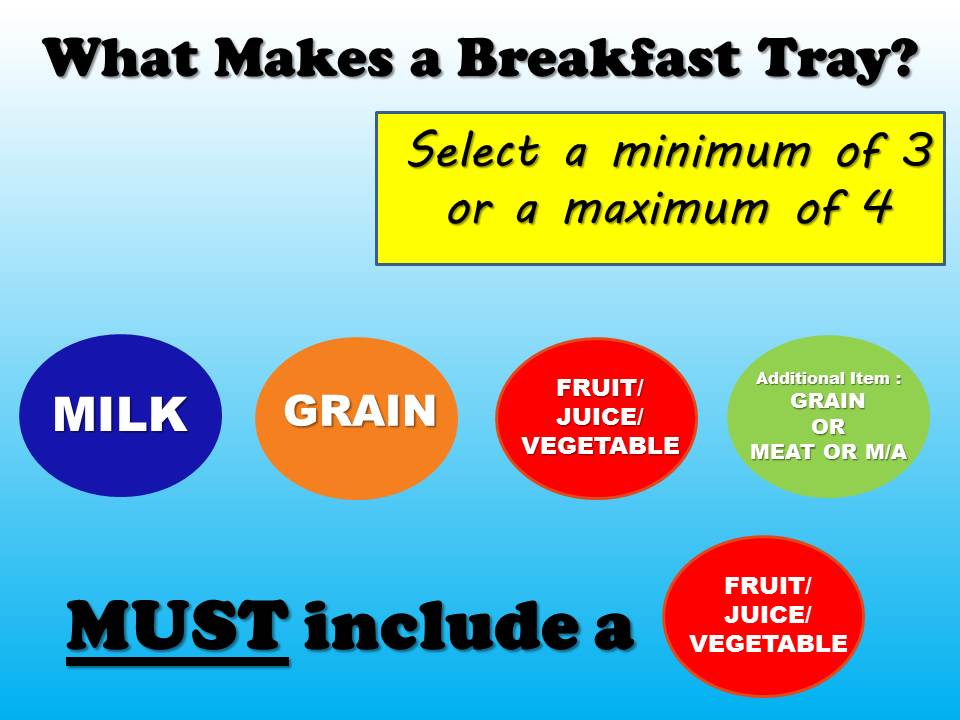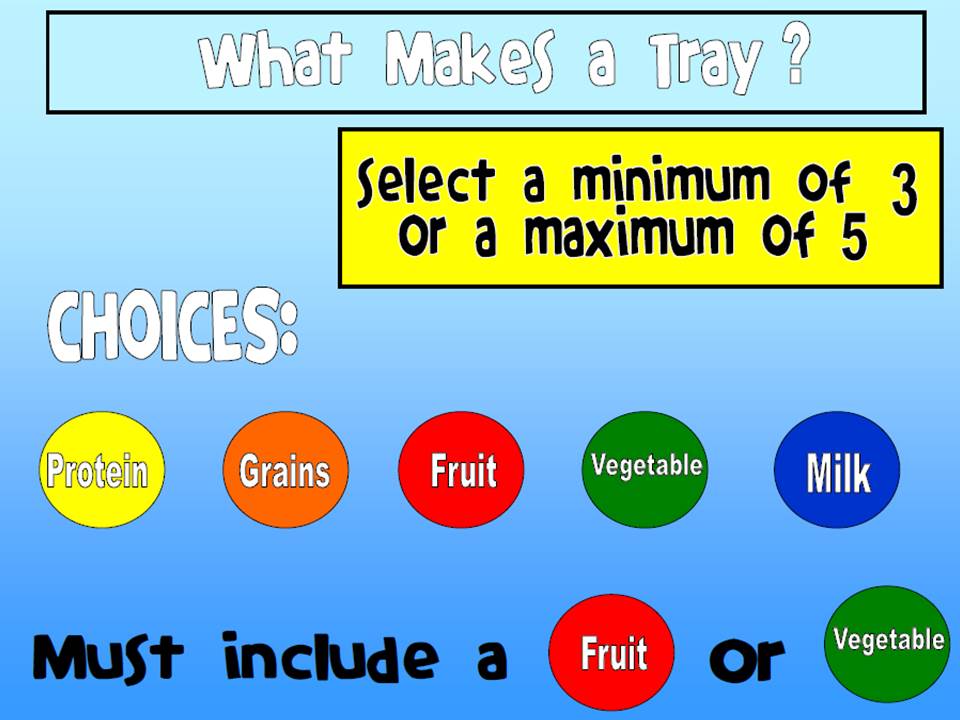Frequently Asked Questions
662.449.7200
How does the National School Lunch Program work?
School divisions that choose to take part in the National School Lunch Program get cash subsidies and donated commodities from the U.S. Department of Agriculture for each meal they serve. In return, they must serve lunches that meet Federal requirements, and they must offer free or reduced-price lunches to eligible children.
School divisions that choose to take part in the National School Lunch Program get cash subsidies and donated commodities from the U.S. Department of Agriculture for each meal they serve. In return, they must serve lunches that meet Federal requirements, and they must offer free or reduced-price lunches to eligible children.
What are the nutritional requirements for school lunch?
School meals must meet the Dietary Guidelines for Americans, which recommend that no more than 30 percent of an individual's calories come from fat, and less than 10 percent from saturated fat. Regulations also establish a standard for school lunches to provide one-third of the Recommended Dietary Allowances of protein, Vitamin A, Vitamin C, iron, calcium, and calories.
School meals must meet the Dietary Guidelines for Americans, which recommend that no more than 30 percent of an individual's calories come from fat, and less than 10 percent from saturated fat. Regulations also establish a standard for school lunches to provide one-third of the Recommended Dietary Allowances of protein, Vitamin A, Vitamin C, iron, calcium, and calories.
What are the nutrition requirements for school breakfast?
School breakfast must meet the Dietary Guidelines for Americans, which recommend that no more than 30 percent of an individual's calories come from fat, and less than 10 percent from saturated fat. Regulations also establish a standard for school breakfast to provide one-fourth of the Recommended Dietary Allowances of protein, Vitamin A, Vitamin C, iron, calcium, and calories.
School breakfast must meet the Dietary Guidelines for Americans, which recommend that no more than 30 percent of an individual's calories come from fat, and less than 10 percent from saturated fat. Regulations also establish a standard for school breakfast to provide one-fourth of the Recommended Dietary Allowances of protein, Vitamin A, Vitamin C, iron, calcium, and calories.
What is a “reimbursable meal”?
For lunch, the federal government, specifically the USDA, defines a “reimbursable meal” or a complete meal, as a meal that consists of at least 3 of the 5 components that are offered daily and one of those choices must be a full serving of fruit or vegetable. Fruits and vegetables are offered in full serving sizes.
For lunch, the federal government, specifically the USDA, defines a “reimbursable meal” or a complete meal, as a meal that consists of at least 3 of the 5 components that are offered daily and one of those choices must be a full serving of fruit or vegetable. Fruits and vegetables are offered in full serving sizes.


What is a “component”?
Think of a “component” as a food group. The 5 daily components include a protein, a grain, a fruit, a vegetable, and milk.
Think of a “component” as a food group. The 5 daily components include a protein, a grain, a fruit, a vegetable, and milk.
Why do I have to take a reimbursable meal?
Mississippi regulation requires each student to take a reimbursable meal.
Mississippi regulation requires each student to take a reimbursable meal.
Are schools required to make menu substitutions for children who cannot eat the regular lunch or breakfast?
Federal law and the regulations for the National School Lunch Program and the School Breakfast Program require schools to make accommodations for children who are unable to eat the school meal as prepared because of a disability. Accommodation generally involves substituting food items, but in some cases schools may need to make more far reaching accommodations to meet the needs of children. For example, some children may need to have the texture modified. In order to make substitutions for items in reimbursable meals, the school must have on file a written statement signed by a licensed physician indicating what the child’s disability is, what foods must be omitted from the child’s diet, and what foods must be substituted.
Federal law and the regulations for the National School Lunch Program and the School Breakfast Program require schools to make accommodations for children who are unable to eat the school meal as prepared because of a disability. Accommodation generally involves substituting food items, but in some cases schools may need to make more far reaching accommodations to meet the needs of children. For example, some children may need to have the texture modified. In order to make substitutions for items in reimbursable meals, the school must have on file a written statement signed by a licensed physician indicating what the child’s disability is, what foods must be omitted from the child’s diet, and what foods must be substituted.
What time are schools required to schedule breakfast and lunch?
Federal regulations require schools to schedule lunch between the hours of 10 a.m. and 2 p.m. There are no specific time requirements for breakfast; federal regulations define breakfast as a meal which is served to children in the morning hours at or close to the beginning of the school day.
Federal regulations require schools to schedule lunch between the hours of 10 a.m. and 2 p.m. There are no specific time requirements for breakfast; federal regulations define breakfast as a meal which is served to children in the morning hours at or close to the beginning of the school day.
Students are able to charge meals in accordance with Federal regulations and the DeSoto County School District student charged meals policy which is as follows:
1. Adults are not allowed to charge meals or solicit food from students.
2. Students can charge meals as follows:
- Students who do not qualify for meal benefits may charge up to $25.00.
- Students who qualify for reduced priced meals may charge up to $4.00.
- Charging a reimbursable meal will result in a negative balance on the student’s account until funds are added to the student’s account.
- Students with a zero or negative account balance will not be allowed to purchase a second meal or a la carte items until the student’s account is in good standing.
- Once a student reaches the maximum charge limit, meals can only be purchased with cash or pre-paid funds on account.
- When a student brings money, that money will first be applied to the purchase of a reimbursable meal; any remainder money will then be applied to negative balances on the student’s account.
- Charging will not be permitted after May 1st of the current school year to allow adequate time to collect student account balances.
May a student bring lunch from home?
We naturally encourage students to eat lunch from the cafeteria however; students may bring a lunch from home. We encourage you not bring in soft drinks or "fast-food" lunches. The sale of soft drinks to students is prohibited from elementary through high school during the school day. The emphasis on nutritional eating is reflected in our Wellness Policy.
We naturally encourage students to eat lunch from the cafeteria however; students may bring a lunch from home. We encourage you not bring in soft drinks or "fast-food" lunches. The sale of soft drinks to students is prohibited from elementary through high school during the school day. The emphasis on nutritional eating is reflected in our Wellness Policy.
Why is the adult charge higher than the student charge?
The intent of the National School Lunch Program is to provide nutritious and low cost meals to children. Since this program is for children, there is no federal assistance or reimbursement for meals served to adults. The value of this reimbursement or assistance must not be used to subsidize adult meals. Therefore, the adult meal charge has to be at least a combination of the basic reimbursement rate plus the guaranteed value of USDA commodities (per plate) and higher than the highest charge to the child in the school district. An adult should receive the same size meal as that of a secondary student for the established charge.
The intent of the National School Lunch Program is to provide nutritious and low cost meals to children. Since this program is for children, there is no federal assistance or reimbursement for meals served to adults. The value of this reimbursement or assistance must not be used to subsidize adult meals. Therefore, the adult meal charge has to be at least a combination of the basic reimbursement rate plus the guaranteed value of USDA commodities (per plate) and higher than the highest charge to the child in the school district. An adult should receive the same size meal as that of a secondary student for the established charge.
This institution is an equal opportunity provider.
For more information, please visit the USDA website at https://www.fns.usda.gov/cr/fns-nondiscrimination-statement.

